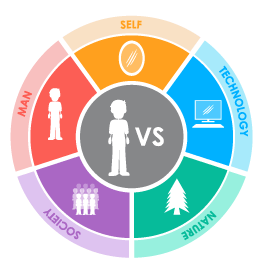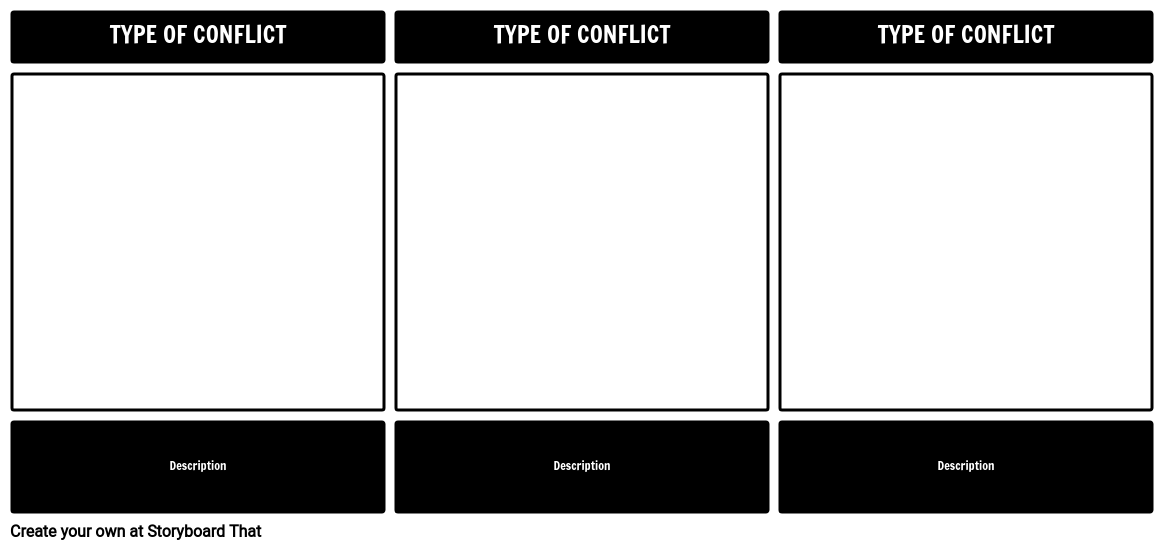Lesson Plan Overview
Literary conflicts are often taught during ELA units. Building on prior knowledge to achieve mastery level with our students is important. An excellent way to focus on the various types of literary conflict is through storyboarding. Having students choose an example of each literary conflict and depict it using the storyboard creator is a great way to reinforce your lesson! In “The Interlopers”, both internal and external conflicts can be found.
Examples of Literary Conflict from “The Interlopers”
MAN vs. SELF
Ulrich’s must overcome his own pride and stubbornness to offer Georg some wine.
MAN vs. SOCIETY
Georg and Ulrich must ignore the 'interlopers', outsiders who would try to interfere with their reconciling.
MAN vs. MAN
Ulrich and Georg start by being bitter enemies, set on killing each other over land.
MAN vs. NATURE
The two men are trapped under a birch tree, which thwarts both of their efforts to kill the other.
Template and Class Instructions
(These instructions are completely customizable. After clicking "Copy Activity", update the instructions on the Edit Tab of the assignment.)
Student Instructions
Create a storyboard that shows at least three forms of literary conflict in “The Interlopers”.
- Identify conflicts in “The Interlopers”.
- Categorize each conflict as Character vs. Character, Character vs. Self, Character vs. Society, Character vs. Nature, or Character vs. Technology.
- Illustrate conflicts in the cells, using characters from the story.
- Write a short description of the conflict below the cell.
Lesson Plan Reference
Student Rubric
(You can also create your own on Quick Rubric.)
| Proficient | Emerging | Beginning | Try Again | |
|---|---|---|---|---|
| Conflict Identification | Student identifies correct major conflicts and uses strong, clear textual evidence to support choice. | Student identifies correct major conflict and uses few or unclear details to support their choice. | Student identifies incorrect major conflict, and uses some details from the text to support their choice. | Student does not attempt to identify major conflict or identifies incorrect major conflict with no explanation. |
| Understanding Outcome | Student clearly shows the outcome of the conflict and its effects on the protagonist with evidence from the text. | Student shows the outcome of the conflict and its effect on the protagonist, but some evidence is unclear. | Student shows the outcome of the conflict, but does not examine its effect on the protagonist and uses some vague textual evidence. | Student does not clearly show the outcome of the conflict or use textual evidence. |
| Character | Storyboard includes all required characters and clearly names them. Goes above and beyond by adding additional details. | Storyboard includes all required characters and clearly names them. | Storyboard includes protagonist and antagonist but leaves out other required characters. | Storyboard does not include the names of required characters. |
| Storyboard | Student clearly shows effort to convey the setting the scene of the book | Student attempts to convey setting and scene of the book, but lacks some clarity. | Student does not clearly convey the setting and scene. | Student makes little or no attempt to convey the setting or scene. |
| Spelling and Grammar | Student uses exemplary spelling and grammar. There are no errors. | Student makes a minor error in spelling and grammar. | Student makes several minor errors in spelling and grammar. | Student makes many errors in spelling and grammar; little attempt at spellchecking. |
Lesson Plan Overview
Literary conflicts are often taught during ELA units. Building on prior knowledge to achieve mastery level with our students is important. An excellent way to focus on the various types of literary conflict is through storyboarding. Having students choose an example of each literary conflict and depict it using the storyboard creator is a great way to reinforce your lesson! In “The Interlopers”, both internal and external conflicts can be found.
Examples of Literary Conflict from “The Interlopers”
MAN vs. SELF
Ulrich’s must overcome his own pride and stubbornness to offer Georg some wine.
MAN vs. SOCIETY
Georg and Ulrich must ignore the 'interlopers', outsiders who would try to interfere with their reconciling.
MAN vs. MAN
Ulrich and Georg start by being bitter enemies, set on killing each other over land.
MAN vs. NATURE
The two men are trapped under a birch tree, which thwarts both of their efforts to kill the other.
Template and Class Instructions
(These instructions are completely customizable. After clicking "Copy Activity", update the instructions on the Edit Tab of the assignment.)
Student Instructions
Create a storyboard that shows at least three forms of literary conflict in “The Interlopers”.
- Identify conflicts in “The Interlopers”.
- Categorize each conflict as Character vs. Character, Character vs. Self, Character vs. Society, Character vs. Nature, or Character vs. Technology.
- Illustrate conflicts in the cells, using characters from the story.
- Write a short description of the conflict below the cell.
Lesson Plan Reference
Student Rubric
(You can also create your own on Quick Rubric.)
| Proficient | Emerging | Beginning | Try Again | |
|---|---|---|---|---|
| Conflict Identification | Student identifies correct major conflicts and uses strong, clear textual evidence to support choice. | Student identifies correct major conflict and uses few or unclear details to support their choice. | Student identifies incorrect major conflict, and uses some details from the text to support their choice. | Student does not attempt to identify major conflict or identifies incorrect major conflict with no explanation. |
| Understanding Outcome | Student clearly shows the outcome of the conflict and its effects on the protagonist with evidence from the text. | Student shows the outcome of the conflict and its effect on the protagonist, but some evidence is unclear. | Student shows the outcome of the conflict, but does not examine its effect on the protagonist and uses some vague textual evidence. | Student does not clearly show the outcome of the conflict or use textual evidence. |
| Character | Storyboard includes all required characters and clearly names them. Goes above and beyond by adding additional details. | Storyboard includes all required characters and clearly names them. | Storyboard includes protagonist and antagonist but leaves out other required characters. | Storyboard does not include the names of required characters. |
| Storyboard | Student clearly shows effort to convey the setting the scene of the book | Student attempts to convey setting and scene of the book, but lacks some clarity. | Student does not clearly convey the setting and scene. | Student makes little or no attempt to convey the setting or scene. |
| Spelling and Grammar | Student uses exemplary spelling and grammar. There are no errors. | Student makes a minor error in spelling and grammar. | Student makes several minor errors in spelling and grammar. | Student makes many errors in spelling and grammar; little attempt at spellchecking. |
How Tos about Types of Conflict in \"The Interlopers\"
Plan a class debate on literary conflicts in 'The Interlopers'
Engage students in a lively debate by assigning them different conflict types from the story. Debates help students articulate their understanding and think critically about each character’s struggles.
Assign conflict types to small groups
Divide your class into groups and give each group a specific conflict type (e.g., Man vs. Man, Man vs. Nature). Focused group work encourages collaboration and deeper analysis.
Guide groups to gather textual evidence
Ask each group to find direct quotes and examples from the text that illustrate their assigned conflict. This step builds close reading and support skills.
Facilitate structured presentations and rebuttals
Have each group present their findings and allow other groups to ask questions or challenge their interpretations. Interactive discussion boosts confidence and comprehension.
Reflect together on key takeaways
Lead a quick class discussion on what was learned about each conflict type and how they shape the story’s meaning. Reflection cements understanding and encourages critical thinking.
Frequently Asked Questions about Types of Conflict in \"The Interlopers\"
What are the main types of conflict in 'The Interlopers'?
"The Interlopers" features several types of conflict: Man vs. Man (Ulrich and Georg's feud), Man vs. Nature (the men trapped by the tree), Man vs. Self (Ulrich's struggle with his pride), and Man vs. Society (the pressure from outsiders). Each conflict drives the plot and reveals character motivations.
How can I teach literary conflict using 'The Interlopers'?
Use storyboarding to have students identify and illustrate at least three types of conflict from the story. Ask them to label each conflict (e.g., Character vs. Character, Character vs. Nature) and write a brief description, helping reinforce understanding through visual and written analysis.
What is the difference between internal and external conflict in 'The Interlopers'?
Internal conflict in the story involves Ulrich's personal struggle with pride and forgiveness. External conflicts include the feud between Ulrich and Georg (Man vs. Man) and their battle against the environment (Man vs. Nature). Both types shape the characters' actions and the story's outcome.
Why is 'The Interlopers' a good example for teaching conflict to middle and high school students?
'The Interlopers' presents clear, relatable examples of multiple conflicts, making it easy for students in grades 6–12 to identify and analyze different types. Its short length and dramatic plot also engage students while supporting key ELA learning objectives.
Can you give examples of Man vs. Nature in 'The Interlopers'?
One major Man vs. Nature example is when Ulrich and Georg are trapped under a fallen birch tree during their confrontation. This conflict with nature prevents them from continuing their feud and ultimately leads to the story's unexpected ending.
More Storyboard That Activities
Interlopers, The
Testimonials

“By using the product, they were so excited and they learned so much...”–K-5 Librarian and Instructinal Technology Teacher

“I'm doing a Napoleon timeline and I'm having [students] determine whether or not Napoleon was a good guy or a bad guy or somewhere in between.”–History and Special Ed Teacher

“Students get to be creative with Storyboard That and there's so many visuals for them to pick from... It makes it really accessible for all students in the class.”–Third Grade Teacher
© 2026 - Clever Prototypes, LLC - All rights reserved.
StoryboardThat is a trademark of Clever Prototypes, LLC, and Registered in U.S. Patent and Trademark Office





